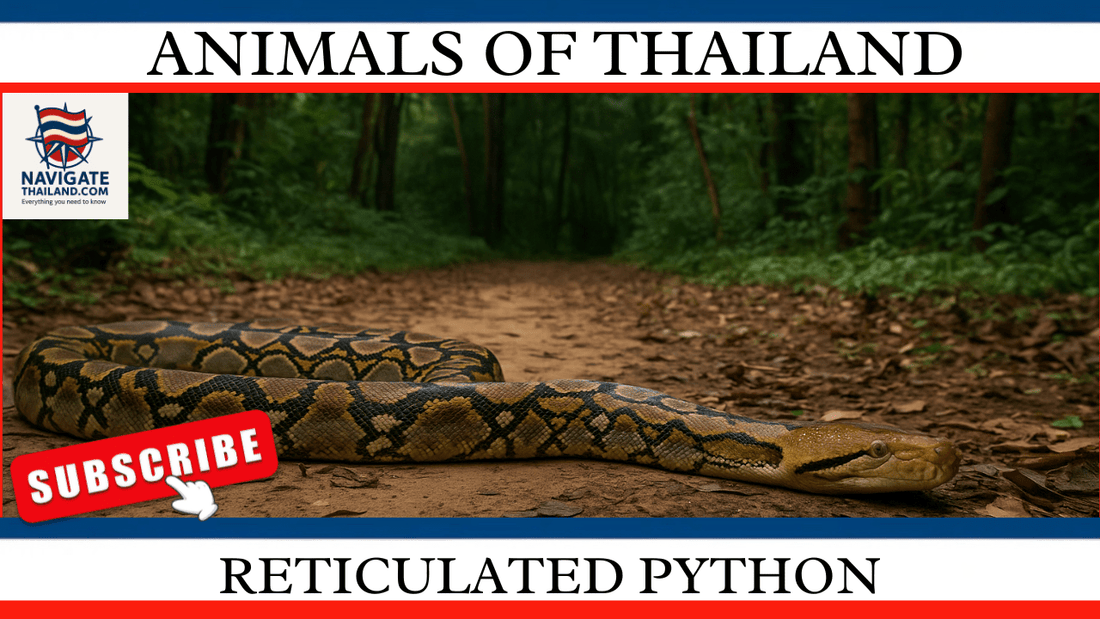
The Reticulated Python: A Giant of the Reptile World
Share
The reticulated python (Python reticulatus) is one of the most magnificent and awe-inspiring creatures on the planet. Known for being the longest snake species in the world, this reptile is native to Southeast Asia and holds a special place in the region’s wildlife. For travellers and wildlife enthusiasts alike, the reticulated python is a must-know species when exploring the dense jungles of Thailand and its neighbouring countries.
This article will take you on a fascinating journey through the world of the reticulated python, covering everything from its habitat and biology to its role in the ecosystem and encounters with humans. We’ll also delve into how to spot them in the wild, fun facts, conservation efforts, and practical tips for those looking to learn more about these incredible reptiles. Whether you’re an adventure traveller or simply curious about Thailand’s wildlife, the reticulated python offers endless intrigue.
What is a Reticulated Python?
The reticulated python is the longest snake in the world, with some individuals reaching lengths of over 9 metres (30 feet), though such giants are rare. Their striking appearance, marked by a complex and beautiful pattern of yellow, olive, and brown scales in a net-like (reticulated) pattern, makes them one of the most recognisable snakes. Despite their size and often intimidating appearance, reticulated pythons are non-venomous constrictors, meaning they rely on their powerful bodies to subdue prey by squeezing rather than using venom.
Size: Adult reticulated pythons generally range between 3-6 metres (10-20 feet), with some individuals growing larger, particularly in areas with abundant food.
Weight: They can weigh up to 160 kilograms (350 pounds), though average adults are lighter.
Lifespan: Reticulated pythons can live for 20-30 years in captivity, and slightly less in the wild due to predation and other environmental factors.
Fun Fact: The longest reticulated python ever recorded was captured in Malaysia in 1912, measuring an astonishing 10 metres (32.8 feet) long!
Native Habitat of the Reticulated Python
The reticulated python is native to Southeast Asia, and its range includes countries such as Thailand, Indonesia, Malaysia, Vietnam, Cambodia, and the Philippines. These snakes thrive in tropical rainforests, grasslands, and wetlands, although they have also adapted to more human-altered environments like agricultural fields and even urban areas.
Where to Find Reticulated Pythons in Thailand
In Thailand, reticulated pythons can be found throughout the country, particularly in forested areas and near water sources such as rivers and swamps. Khao Sok National Park in southern Thailand is one of the best places to spot these snakes in their natural habitat, along with other wildlife like elephants, gibbons, and hornbills.
These snakes are known to be semi-aquatic, meaning they are often found near water and are excellent swimmers. They are even known to inhabit small islands off the coast of Southeast Asia, travelling between them by swimming in the ocean.
Fun Fact: Reticulated pythons are capable swimmers and have been spotted miles off the coast, swimming between islands in Southeast Asia!
Diet and Hunting Behaviour
Reticulated pythons are carnivorous and have a diet that changes as they grow. They are ambush predators, meaning they rely on stealth and patience to capture their prey. These snakes have highly developed sensory organs, including heat-sensing pits along their upper lips, which allow them to detect the body heat of warm-blooded prey even in complete darkness.
What Do Reticulated Pythons Eat?
Juveniles: Young pythons typically feed on smaller animals such as rodents, birds, and small reptiles.
Adults: As they grow, reticulated pythons graduate to larger prey, including wild boar, deer, and even primates. In areas where they come into contact with human populations, they have been known to prey on livestock such as chickens, goats, and pigs.
Fun Fact: Reticulated pythons are capable of consuming prey that is up to one-quarter of their own body weight in a single meal! Their flexible jaws can stretch wide enough to swallow animals much larger than their head.
How Do They Hunt?
As ambush predators, reticulated pythons rely on their excellent camouflage to blend into their environment. They lie in wait for prey to come close before striking out with incredible speed, grabbing their target with their sharp, backward-facing teeth. Once they have a firm grip, they coil their powerful bodies around the animal and constrict it, squeezing tightly until the prey suffocates.
After killing their prey, pythons use their stretchy ligaments to open their jaws wide and slowly swallow the animal whole, starting with the head. Digestion can take days to weeks, depending on the size of the meal.
Reticulated Pythons and Human Encounters
Because of their large size and predatory nature, reticulated pythons have a complex relationship with humans, especially in regions where their habitats overlap with human settlements. While these snakes are generally not aggressive towards people, there have been instances where humans have been attacked, particularly in cases where pythons have mistaken them for prey.
Are Reticulated Pythons Dangerous?
Reticulated pythons are not venomous, and attacks on humans are rare. Most human-predator conflicts arise when these snakes are provoked or feel threatened. In some instances, particularly in rural areas, they may prey on livestock, leading to conflicts with farmers.
That said, it is important to exercise caution when in areas known to be inhabited by large pythons. These snakes can be unpredictable, especially when cornered or surprised.
Fun Fact: Although human encounters with reticulated pythons are rare, there have been reports of pythons swallowing people whole. In 2017, a shocking case in Indonesia made headlines when a 7-metre python swallowed a farmer, highlighting the strength and predatory instincts of these snakes.
Python Farming in Thailand
In Thailand, reticulated pythons are sometimes bred in captivity, both for the exotic pet trade and for their skins, which are used to produce leather goods such as shoes, bags, and belts. While python farming provides an alternative to capturing wild snakes, it raises ethical concerns about animal welfare and the impact on natural populations.
Conservation Status
The conservation status of the reticulated python is complex, as the species is not currently considered endangered. However, like many large reptiles, they face threats from habitat destruction, hunting, and the exotic pet trade.
Threats to Reticulated Pythons
Habitat Loss: Deforestation and urbanisation are major threats to the reticulated python’s natural habitat, particularly in Southeast Asia. As their forest homes are cleared for agriculture or development, these snakes are forced into closer proximity with humans, leading to increased conflict.
Hunting and the Exotic Pet Trade: Reticulated pythons are also hunted for their skins, which are highly prized in the fashion industry. Additionally, their striking appearance makes them popular in the exotic pet trade. While some pythons are bred in captivity, others are captured from the wild, which can negatively impact local populations.
Conservation Efforts
In some countries, reticulated pythons are protected under local laws, and international trade is regulated by CITES (Convention on International Trade in Endangered Species) to prevent over-exploitation. Conservationists are also working to raise awareness about the importance of preserving the natural habitats of these snakes and reducing human-wildlife conflict.
Fun Fact: Reticulated pythons are responsible for controlling populations of small mammals in their ecosystems, playing a vital role in maintaining the balance of their habitats.
How to Spot Reticulated Pythons in the Wild
For those hoping to catch a glimpse of a reticulated python in the wild, Thailand offers several opportunities to do so. Reticulated pythons are elusive, but with patience and the right guide, you may be able to spot one in its natural habitat.
Best Locations to See Reticulated Pythons in Thailand
Khao Sok National Park: This large park in southern Thailand is one of the best places to see reticulated pythons, along with other wildlife like tapirs, hornbills, and gibbons. The park’s dense rainforests and proximity to water make it an ideal habitat for these snakes.
Phang Nga Bay: This region, famous for its limestone cliffs and islands, is another great location for spotting reticulated pythons. They are often found in mangroves and along rivers.
Safety Tips for Encounters
Do Not Approach: If you see a reticulated python in the wild, admire it from a safe distance. These snakes are not typically aggressive, but they will defend themselves if threatened.
Travel with a Guide: If you’re hoping to spot a reticulated python, it’s best to travel with an experienced guide who knows the local wildlife and terrain. They can help ensure a safe and respectful encounter.
Stay on Marked Trails: When exploring national parks or forested areas, stick to marked trails to reduce the chances of encountering wildlife unexpectedly.
Reticulated Pythons in Captivity
Reticulated pythons are a popular species in zoos and private collections due to their size and beauty. However, keeping a reticulated python as a pet requires significant care and expertise, and it’s not recommended for novice reptile owners.
Pet Care and Husbandry
For those who are experienced with large snakes, reticulated pythons can be rewarding pets, but they require specialised enclosures, heat and humidity controls, and a diet of large prey like rabbits. They also need ample space to move and grow, as adult pythons can become quite large.
Fun Fact: In captivity, reticulated pythons can become tame with regular handling, though they should always be handled with caution due to their size and strength.
Conclusion
The reticulated python is a remarkable species that commands both respect and fascination. Whether encountered in the wilds of Thailand’s national parks or admired from afar in captivity, these giant reptiles offer a unique insight into the biodiversity of Southeast Asia. From their incredible hunting abilities to their important role in the ecosystem, reticulated pythons are a symbol of the power and beauty of nature.
For travellers visiting Thailand or other parts of Southeast Asia, learning about reticulated pythons and their habitats is an enriching experience that adds depth to any wildlife adventure. By supporting conservation efforts and appreciating these animals in their natural environments, we can help ensure their survival for generations to come.
Encourage your fellow travellers and wildlife enthusiasts to share their thoughts and experiences in the comments below. Don’t forget to share this blog on your social media platforms! Stay tuned for future posts and videos on our YouTube channel, where we turn our in-depth blogs into engaging wildlife documentaries. Like and subscribe to help us become the leading source of factual information on all things related to Thailand!
References:
National Geographic – https://www.nationalgeographic.com
International Union for Conservation of Nature (IUCN) – https://www.iucn.org
Bangkok Post – Reticulated Pythons and Wildlife in Thailand
Read more of our Thailand blog series:
Thai Food Guide:Traditional Recipes and Street Eats
Everything Travellers Need to know
Thailand travel ebooks and language guides
Thailand Travel Apparel & Souvenir Gifts
Subscribe to our YouTube channel Navigate Thailand to see our most popular Thailand travel blogs turned into videos:
Navigate Thailand YouTube channel










































































































































